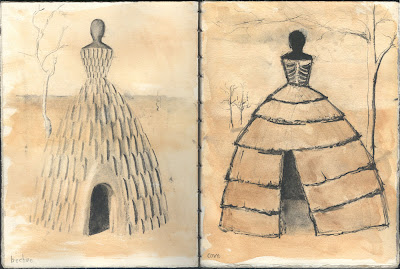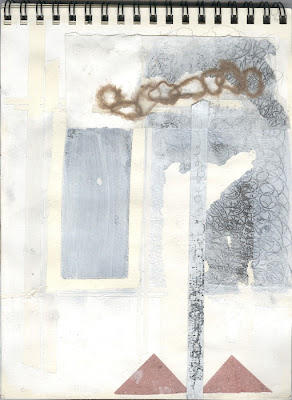Mien's little clementine made me smile (was that two weeks three months ago really?), reminded me of a few sketches from an old sketchbook titled Book of House and Travel, and then had me pondering a chain of thought I began a few years ago and never quite concluded. The drawings were part of my explorations of houses as female-dominated spaces and shapes (see Dwelling), which were intensified after I learned in my African art and architecture studies that in some places(please forgive me, I have forgotten even which country much less ethnicity), men and women live in separate houses. I was particularly captured by the revelation that men's houses were rectangular while the women's houses were round cylinders or domes. Then I read something related to male and female ownership of shelter in another culture, the Fulani Hausa (Sub Saharan region), which I dutifully noted in my Daughters sketchbook (notes from Labelle Prussin "Fulani Hausa Architecture" African Arts (volume ?) p.8-19:
The critical aspect of change [sedentarization] was the shift in ownership of and jurisdiction over the residential structure. Among the nomadic peoples of W. Africa savannah, all property relating to the domestic domain including the bed, canopied or not, the tent whether a mat or skin or that bed covered one and its armature, belongs to the wife. It is also the women who assemble and dismantle the domestic structures. Even in instances where the woman does not weave the mats or tapestries, or tan the skins, it is the responsibility of the wife's family to provide them, either as part of the dowry or upon the birth of the first child. The single deviation from this pattern is when there is central support for the tent structure: then the husband plants and erects the central post.
Among the sedentary populations of the savannah . . . ownership and jurisdiction over earthen structures of any kind, regardless of their former technology, are in the hands of the male members of the household or kinsmen group. With the sedentarization of a nomadic tent, the mat walls are replaced by an earthen wall (coil or brick); the tent armature is enveloped by an earthen covering and mobile interior furnishings are gradually replaced by earth-molded ones.
As the armature becomes attached to, then embedded in the earthen walls, the woman looses proprietorship over the domicile structure and those furnishings that continue to constitute her dowry, such as the wedding pillow and the assortment of utensils associated with food and procreation of offspring. (Labelle Prussin)
This article plays into my fascination with the idea of womb as a nomadic form of architecture (a structure of bone and flesh) and skirt as house which I explored with Dwelling and later with an unsuccessful attempt at a tent hoop skirt (good idea just lackluster execution, and anyway I spotted some rather fun ones recently in Craft Magazine by Robin Lasser and Adrienne Pao). But what the author of the above article does not address is the specific belief set that brought about this change, so I am left to mull the question by myself:
-In switching from a nomadic herding-trading lifestyle to a agricultural one in which a family's wealth is no longer indicated by the number of livestock and quantity of rare jewels but to one which wealth is indicated mostly by ownership of land*, did the concept of land ownership and domination logically lead to male ownership of house? *Now I am speculating somewhat on this because I don't really know that land is owned by agricultural Fulani-Hausa men in the same sense that land is owned by Westerners today, or even that they were not in fact switching to an urban lifestyle instead of an agricultural one but I believe the latter a sound guess, in part because the flow in most cultures seems to follow that nomads turn to farmers who turn to city dwellers.
-Does ownership of the increasing earthbound house signify that man could claim dominion of the earth herself and thus her fecundity?
-Was it simply a practical matter that during travel, while men attended to the maintenance of the herds the woman attended the house as she attends her body: clothing it and then filling it with new members of the home? But when the house became stationary, the work of maintenance fell to men (moving earth now instead of cloth).
-Is this evidence of a matriarchy turning to patriarchy?
-The image of the earth reaching up and binding the house down to it seems a strong image of burial.
-And in any case why and how is that women could not (or would not) retain ownership of her home?
It is that last question that drives me, and having recently read Mists of Avalon I am dwelling increasingly on the roles of women in early society and the way Marion Zimmer Bradley crafts a society navigating the power shift from a Druid matriarchy to a Christian patriarchy. Finally today I wonder about the possibility and meaning of a US president who was first wife to the President. [and here is the reason for the long pause between beginning this entry and posting it] Why is the possible)jump to a female President precluded by her being the wife of President? It's a question I grapple uneasily with; it seems a bit nepotistic that one household would mark a historic change for a country breaking a gender barrier and finally allowing a woman to lead the nation, it is both too neat and tidy (a good fictional device like Morgan la Fey being usurped by her brother/lover Arthur) and too messy (with their personal domestic history known fully to the world).
My feelings are made more complex by the fact that I always fully expected I would vote for a woman presidential candidate when it became a possibility, and yet in February I sat in my Florida voting booth and marked that skinny oval for Obama.
Anyway here are few more images from the same sketchbook.













